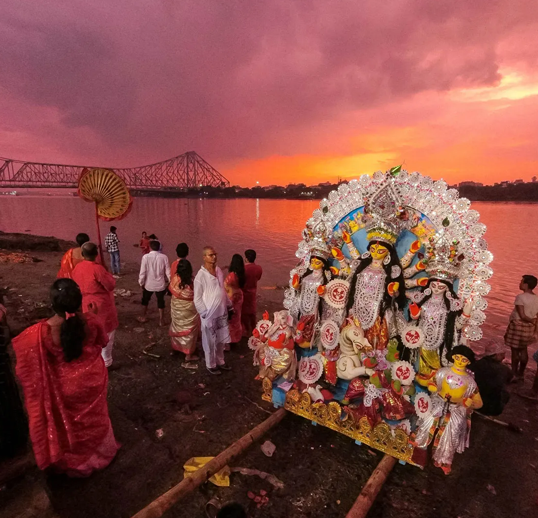

Nature subtly yet significantly enhances the atmosphere for Durga Puja. Autumn brings an abundance of flowers like marigolds, chrysanthemums, and rajanigandha (tuberose), which are used in the intricate decorations of pandals. Their vibrant colors and fragrances contribute to the festival's lively ambiance. Additionally, the festival coincides with the end of the harvest season, a time of plenty where the abundance of grains and fresh produce is celebrated with special foods and offerings. While nature doesn’t actively "prepare" for Durga Puja, its seasonal changes and resources seamlessly enrich the festival's vibrant and celebratory spirit.
The clear blue skies with fluffy clouds, a teeny tiny bit chilly October wind blowing and Shiuli Phool falling from its branches one by one signals the arrival of Durga Maa. The Parijat, or Shiuli as we lovingly call it, signals the arrival of Sharad and thus the Sharadotsava or the Durga Puja, a time for all of us to shed our worries, spring clean our lives and rejoice. The fragrance of Shiuli Phool is very intoxicating as we are knocking on the door for the grand celebrations of Durga Puja.

Legend has it that this flower is from a heavenly tree that was brought to Earth by Lord Krishna, one of the central gods in the Hindu pantheon. Interestingly, in a somewhat unusual twist, this tree is considered so sacred that its flowers picked up from the ground are also deemed appropriate for worship, to make sacred offerings.
This is only one of the many gifts of nature, the exquisitely fragrant flowering tree which sheds blossoms and carpets the Earth around it.
Lotus flower's symbolism of purity, divine beauty, and spiritual significance makes it a key element in Durga Puja, representing the qualities of the goddess and the themes of the festival. On the third day, Maa Durga is worshipped as Mata Chandraghanta with Lotus. This alludes to her third eye being permanently open to fight evil in an instant.
The lotus flower also signifies that Maa embodies divine grace and beauty, rising above worldly imperfection. The blooming process of lotus from the mud reflects the cycle of life, creation, and renewal, which resonates with the festival’s themes of victory and rejuvenation.
The hibiscus represents purity and divine beauty. Its vibrant colour and delicate petals are symbolic of the divine grace and the purity of the devotee’s intentions. The bright red or pink hues of the hibiscus are thought to be particularly auspicious and pleasing to the goddess. In some interpretations, the hibiscus is also associated with prosperity and good fortune. Its use in the puja ceremonies is believed to invite positive energy and blessings from the goddess.
The rose's significance in Durga Puja lies in its role as a symbol of devotion, purity, and beauty, as well as its enhancement of the ritual’s visual and aromatic appeal. On the fifth day, Maa manifests in the form of Skandmata. So, red and yellow flowers are very near to her. Maa Durga is the symbol of bravery, courage,
empathy and mercy. Since the rose is associated with love and compassion, offering the rose during the celebration devotees can receive her mercy.

Marigold: On the sixth day, Maa Durga is in the form of Katyayani Devi, the most ferocious one. For prosperity, wealth and good health, marigold is offered. Marigolds also bloom abundantly during the autumn season, which coincides with Durga Puja. This seasonal availability makes them a practical and traditional choice for the festival's decorations and offerings.
Butterfly Pea: Also known as the Aparajita flower and is another sacred one. Aparajita derived from the Sanskrit word “aparajita,” is another name for Maa Durga, which means “unconquerable”. This flower is also offered to Shiva. Aparajita symbolises resilience and beauty.
Nature’s rhythm harmonizes perfectly with Durga Puja, crafting a backdrop of beauty, celebration, and renewal that deepens the festival's joy and significance. These flowers, rich in religious meaning, also enhance the visual and sensory ambiance, transforming Durga Puja into a vibrant, fragrant tribute to divine femininity and the victory of good over evil.